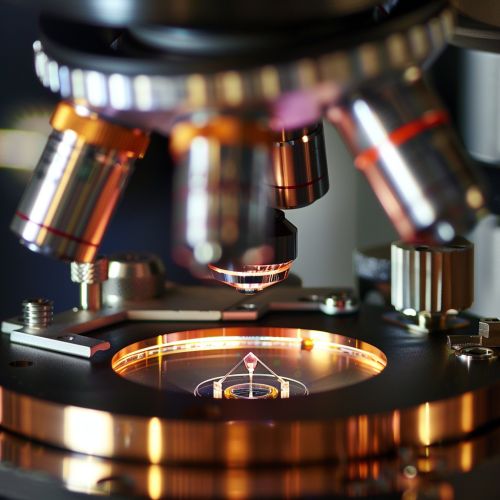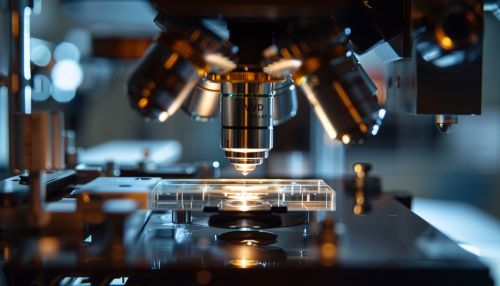Quantum conductance: Difference between revisions
(Created page with "== Introduction == Quantum conductance is a fundamental concept in the field of quantum mechanics and condensed matter physics. It describes the quantized nature of electrical conductance in nanoscale systems, such as quantum wires and quantum dots. This phenomenon arises due to the wave-like properties of electrons and the discrete energy levels that they occupy in confined systems. Quantum conductance plays a crucial role in the development of modern nanotechnology and...") |
No edit summary |
||
| (One intermediate revision by the same user not shown) | |||
| Line 22: | Line 22: | ||
Quantum point contacts (QPCs) are narrow constrictions between two wider electron reservoirs. They are commonly used to study quantum conductance. When the width of the QPC is comparable to the electron wavelength, the conductance becomes quantized. This quantization is observed as a series of plateaus in the conductance versus gate voltage plot, with each plateau corresponding to an integer multiple of \( G_0 \). | Quantum point contacts (QPCs) are narrow constrictions between two wider electron reservoirs. They are commonly used to study quantum conductance. When the width of the QPC is comparable to the electron wavelength, the conductance becomes quantized. This quantization is observed as a series of plateaus in the conductance versus gate voltage plot, with each plateau corresponding to an integer multiple of \( G_0 \). | ||
[[Image:Detail-92787.jpg|thumb|center|A quantum point contact device under a microscope.|class=only_on_mobile]] | |||
[[Image:Detail-92788.jpg|thumb|center|A quantum point contact device under a microscope.|class=only_on_desktop]] | |||
=== Quantum Dots === | === Quantum Dots === | ||
Latest revision as of 06:58, 21 June 2024
Introduction
Quantum conductance is a fundamental concept in the field of quantum mechanics and condensed matter physics. It describes the quantized nature of electrical conductance in nanoscale systems, such as quantum wires and quantum dots. This phenomenon arises due to the wave-like properties of electrons and the discrete energy levels that they occupy in confined systems. Quantum conductance plays a crucial role in the development of modern nanotechnology and quantum computing.
Historical Background
The concept of quantum conductance was first experimentally observed in the late 1980s. The pioneering work of physicists such as Richard Feynman and the subsequent experimental confirmation by scientists like Ben van Wees and his colleagues at the Delft University of Technology provided the foundation for understanding this phenomenon. Their experiments demonstrated that the conductance of a quantum point contact is quantized in units of \( \frac{2e^2}{h} \), where \( e \) is the elementary charge and \( h \) is Planck's constant.
Theoretical Framework
Quantum Mechanics and Conductance
In classical physics, electrical conductance is described by Ohm's law, which relates the current flowing through a conductor to the applied voltage and the resistance of the material. However, at the nanoscale, classical descriptions fail to account for the wave-like behavior of electrons. Quantum mechanics provides the framework to understand conductance at this scale.
In a quantum system, electrons exhibit both particle-like and wave-like properties. When electrons are confined in a small region, such as a quantum wire, their energy levels become quantized. This quantization leads to discrete conductance values, which are integer multiples of the conductance quantum \( G_0 = \frac{2e^2}{h} \).
Landauer-Büttiker Formalism
The Landauer-Büttiker formalism is a theoretical approach used to describe quantum conductance. It treats the conductance of a quantum system as a transmission problem, where electrons are transmitted through a potential barrier. The conductance is determined by the transmission probability of electrons through the barrier.
According to this formalism, the conductance \( G \) of a quantum wire is given by: \[ G = G_0 \sum_{n} T_n \] where \( T_n \) is the transmission probability of the \( n \)-th mode, and the sum is over all available modes. Each mode corresponds to a discrete energy level in the quantum wire.
Experimental Observations
Quantum Point Contacts
Quantum point contacts (QPCs) are narrow constrictions between two wider electron reservoirs. They are commonly used to study quantum conductance. When the width of the QPC is comparable to the electron wavelength, the conductance becomes quantized. This quantization is observed as a series of plateaus in the conductance versus gate voltage plot, with each plateau corresponding to an integer multiple of \( G_0 \).


Quantum Dots
Quantum dots are nanoscale semiconductor particles that confine electrons in all three spatial dimensions. They exhibit discrete energy levels similar to atoms, leading to their nickname "artificial atoms." The conductance through a quantum dot is also quantized, and it can be controlled by tuning the energy levels using external gate voltages.
Applications
Nanoelectronics
Quantum conductance is a key principle in the development of nanoelectronic devices. Quantum wires and quantum dots are used to create transistors, sensors, and other components with superior performance compared to their classical counterparts. The quantized conductance allows for precise control of electronic properties at the nanoscale.
Quantum Computing
In quantum computing, quantum conductance is utilized to manipulate and read out the states of qubits. Quantum dots can serve as qubits, with their discrete energy levels representing different quantum states. The ability to control conductance at the quantum level is essential for the development of scalable and reliable quantum computers.
Challenges and Future Directions
Despite the significant progress in understanding and utilizing quantum conductance, several challenges remain. One major challenge is the fabrication of stable and reproducible quantum devices. Variations in material properties and fabrication techniques can lead to inconsistencies in conductance measurements.
Future research aims to address these challenges by developing new materials and fabrication methods. Additionally, exploring the interplay between quantum conductance and other quantum phenomena, such as entanglement and coherence, could lead to novel applications in quantum technology.
See Also
- Quantum Mechanics
- Condensed Matter Physics
- Quantum Wire
- Quantum Dot
- Quantum Computing
- Landauer-Büttiker Formalism
- Quantum Entanglement
- Quantum Coherence
References
[References would be listed here if available]
